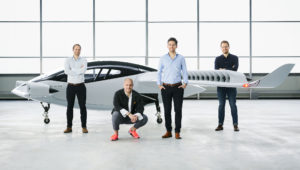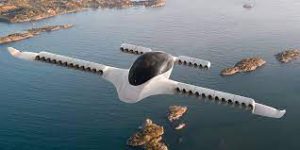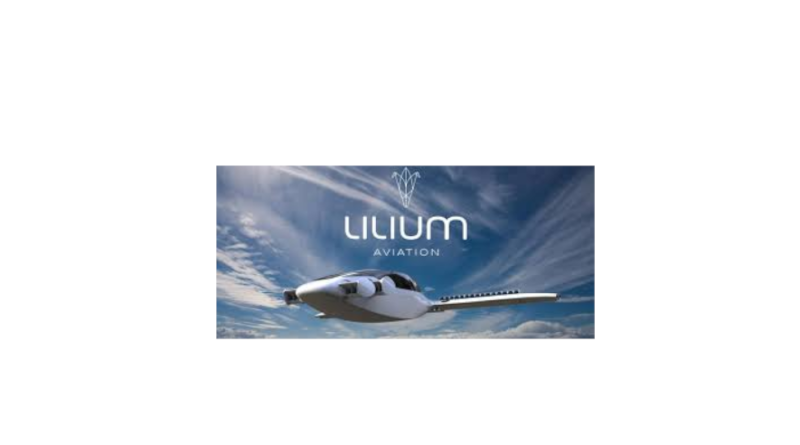Lilium Jet is a Germany-based start-up co-founded in 2015 by four aerospace engineers and product designers — Daniel Wiegand, Sebastian Born, Patrick Nathen and Matthias Meiner — all from the Technical University of Munich.
Daniel Wiegand originally conceived the basic electric Vertical and Take-Off and Landing (eVTOL) jet concept in 2013. There were four sub-scale prototypes named the Gleiter, Hexa, Dragon and Falcon. Then a full-scale two seat “Eagle” prototype was created and completed a series of unmanned test flights in April 2017. Following the successful test flights of the Eagle prototype, Lilium moved forward with a five seat full-scale production model.

On May 16, 2019, Lilium revealed they had announced its first flight of an untethered and unmanned five seater Lilium Jet which took place on May 4, 2019 at the Special Airport Oberpfaffenhofen airport in Munich, Germany. Extensive ground testing took place before its maiden flight. The full-scale prototype is powered by 36 all electric ducted fans which allows for a vertical take-off and landing with an efficient horizontal flight.

Simplicity is one of the key design elements for Lilium. There are many things you can leave out of an aircraft to keep complexity to a minimum which translates into lower manufacturing costs, lower maintenance costs, greater safety (less things can fail), greater affordability, less weight and increases efficiency. The company stated that every component that is not there, does not have to be developed and does not need to be maintained. Listed below are a few items about the importance of simplicity of the Lilium Jet eVTOL aircraft.
- No folding propellers or wings
- No tail
- No rudder
- No propellers
- No gearboxes
- No tilting wings
- No water cooling
- No liquids (petroleum fuel or oil)
- No single point of failure. (Example of a single point of failure: If an aircraft has one engine [such as a Cessna 150] and that one engine fails, that is a single point of failure.)
- Wings provide greater efficiency for forward flight
- Each electric motor has one moving part
- 36 ducted fans provide ultra-redundancy

With a top speed of 300 km/h (186 mph) and a range of 300 km (186 m), the Lilium Jet is capable of completing much longer journeys than the majority of its competitors. This is, in part, due to the fixed-wing design of the aircraft. While multicopter-based aircraft consume much of their energy keeping an aircraft in the air, the Lilium Jet can rely on the lift generated by the fixed-wing to do this, meaning it will require less than 10 percent of its maximum 2,000 horsepower when it reaches its cruise flight.
Of course, that 300 km (186 mph) range is maximum possible range, not accounting for headwinds, reserves and current battery efficiency. As stated by Walker-Jones, “We’re not expecting the current prototype that you see flying around today to fly 300 kilometers. We don’t promise that it will fly 300 kilometers. We’re thinking forward to 2025 and not just having an aircraft that’s been optimized to travel distance as best as possible but also the improvement that you should see in battery [energy] density.”
The idea of ‘urban air mobility’ is pretty well ingrained in most people’s minds. Its futuristic flying cars that hop around a city, perhaps taking off from a garden, before stopping at the local shops, and then dropping the kids off at school.
Of course, the reality is very different.

Taking a short hop from Lower Manhattan to Grand Central Station in New York, or from the English Garden in Munich to the main station, is not only impractical (you’d need hundreds of landing pads in one city) but it won’t actually save you any time as you’ll likely need to travel to and from the vertiport as well as check-in for your journey.
Instead, Lilium envisions something different. Different from what most people expect from electric air mobility and different from the vast majority of their competitors.
With a range of up to 300km (186 miles), they’ll be able to focus on connecting entire regions with high-speed transport, rather than trying to persuade you that we’re quicker than a crosstown journey on an underground train or bike.
But the opportunity doesn’t stop there. Because an air mobility service doesn’t require expensive land-based infrastructure like roads or rails connecting each point, we can rapidly create a network with hundreds, if not thousands of route options, linking up major towns and cities to create significant economic impact, better land use, and increased access to industry, culture and, of course, nature.
A system with only 20 landing sites would create around 200 potential routes and 10,000km of high speed connectivity (assuming 50km distance between sites). That’s three times the entire French high speed TGV rail network for a fraction of the cost. And since we don’t have to build tracks that can easily cost more than $20M+ per kilometer, we can connect smaller communities too, adapting the frequency of connection to match the demand. By adapting existing infrastructure like airports, heliports, or even the roof of a parking garage, there’s a genuine opportunity to implement any given network in less than five years.
This is the dawn of the new jet set!


















































